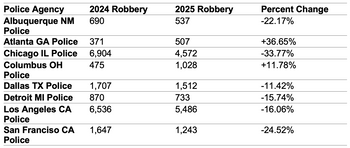Key Takeaways
- Broad Decrease: Violent crimes, including Homicides and Robberies, have reduced significantly in major U.S. and Canadian cities according to the latest survey.
- Comprehensive Coverage: The survey includes Homicide, Sexual Assault, Robbery, and Aggravated Assault data from 67 U.S. cities and 9 Canadian cities.
- National vs. Local Trends: While national violent crime trends in 2025 show decreases, city-level data reveal unique crime patterns, such as Boston's unexpected Homicide increase.
- Aggravated Assault Impact: As the most frequent violent crime, Aggravated Assault significantly influences community safety perceptions.
- Timely Insights: This violent crime survey offers insights and current data, unlike other programs that experience delays, aiding in effective risk management and policymaking.
Major North American Cities in the U.S. and Canada report a decrease in violence, according to the newly released annual Violent Crime Survey from the Major Cities Chiefs Association. The survey is an annual comparison of the violent crime statistics covering the year from January 1 to September 30. This year’s data includes 67 city police departments from the United States and nine city police departments from Canada. The survey provides insights into offense counts for Homicide, Sexual Assault, Robbery, and Aggravated Assault — the same index crimes that produce the U.S. Federal Bureau of Investigation’s (FBI) measurement of violent crime in their Uniform Crime Reporting (UCR) program.
This is a smaller sample of agencies than the FBI’s UCR program, which ultimately receives data from more than 18,000 law enforcement agencies and provides coverage for an estimated 95% of the U.S. population. The Major Cities Chiefs Association crime data does not encompass the final three months of any given year. Despite this, it is a powerful indicator and analysis of urban crime trends and does not experience the same lags as the FBI’s program or the Department of Justice’s victimization survey, providing real, current data from places that are frequently locations of interest in the national crime conversation.
According to nationwide aggregates, both Canada and the U.S experienced modest decreases across all offense types. The United States recorded a 19% decrease in Homicide, a 6% decrease in Sexual Assault, an 18% decrease in Robbery, and a 10% decrease in aggravated assault.
In Canada, they reported a 30% decrease in Homicide, a 3% decrease in Sexual Assault, a 4% decrease in Robbery, and a 6% decrease in aggravated assault.
Zooming in to the city level produces a much greater variety in signal strength or whether numbers are moving up or down.

As seen above, incidence numbers vary strongly from city to city due to base populations and offense rates, and these percentage changes can misplace emphasis on signal strength. For instance, Boston’s increase of eight Homicides, producing a 44% change, appeared to dwarf Chicago’s percentage change, driven by 127 fewer Homicides.
Canada’s city-level view of Homicide shows consistent decreases offset by a few outliers that showed growth. When comparing large percentage swings in opposite directions — as between Toronto, Ontario and Vancouver, British Columbia — it is worth noting the actual offense counts.

American numbers reporting Robbery reductions closely trailed aggregate Homicide statistics, and tell a similar story, where the scope of Robbery offenses from city to city varies widely and mere percentage changes can be deceptive.

Canadian Robbery data shows an almost even split, with several reporting agencies holding even, or showing a single-digit change, and half of the agencies showing double-digit changes in opposite directions.

Despite aggregate decreases at the national level, reports of Sexual Assault increased in 21 of the reporting American cities.

In Canada, 4 out of 9 reporting agencies saw increases in Sexual Assault, but unlike America’s data, these increases were relatively small and offset by larger decreases.

Aggravated Assault, due to its high frequency, plays a significant role in shaping our understanding of violent crime. As the predominant violent index crime, it heavily influences community safety indicators used by experts and policymakers alike. Recognizing this need for detailed insights, the Pinkerton Crime Index (PCI) Dashboard offers users comprehensive views into the distribution and severity of index crimes in their specific areas. This tool provides individuals and organizations with a deeper and more precise understanding of local crime dynamics for informed decision-making and safety strategies.

Canadian data on Aggravated Assault is driven by several major cities showing robust declines.

The Major Cities Chiefs Associations annual Violent Crime Survey is another powerful tool available to criminologists, statisticians, and other interested parties. It allows a window into the current year of crime data, citing the same offenses that drive the FBI’s annual publications, without operating at the same lags. This allows decision-makers and policymakers, as well as law enforcement, risk management, and crime forecasting professionals, to assess the reality of their expectations for 2025 and to begin assessments for 2026.
Frequently Asked Questions (FAQs):
1. What is the prevalent finding of the Violent Crime Survey for 2025?
The survey showed broad reductions in city-level violent crime trends in 2025, including major decreases in Homicides and Robberies across major U.S. and Canadian cities.
2. Which crimes are included in this survey?
The survey includes Homicide, Sexual Assault, Robbery, and Aggravated Assault.
3. How does this survey compare to the FBI's Uniform Crime Reporting?
Unlike the FBI's UCR, which gathers data from over 18,000 agencies, this survey focuses on a smaller sample but offers more timely insights.
4. Are there any significant differences between U.S. and Canadian crime statistics?
Both countries saw reductions in crime, but the variance among cities and crime types was more pronounced in U.S. cities.
5. Who benefits from the insights provided by this survey?
Policymakers, law enforcement officials, criminologists, and risk management professionals use this data for planning and assessment.





